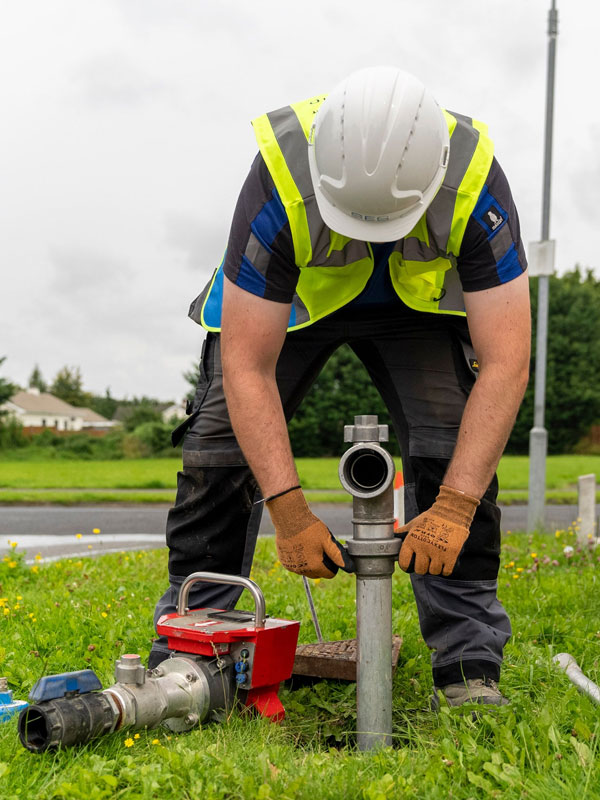SES Water
Flow & Pressure Testing
What Do We Do?
We provide fire hydrant flow and pressure testing for clients across a broad range of sectors and industries. Hydrant testing is an important aspect in maintaining a reliable water network to ensure hydrants are ready in the event of a fire emergency.
Hydrant testing is carried out in accordance with BS9990/5306 & I.S.391. Using the latest calibrated flowmeter equipment and methods, we can establish the maximum sustainable flow rate of a hydrant and record static and residual pressures in the process.

Why is Hydrant Testing Required
Whether you are hydrant testing for insurance renewal purposes or to confirm available flow and pressure for planning applications, SES offer the latest methods and certified equipment to meet your needs.
Fire hydrants should be tested on an annual basis to confirm they meet all the required standards. Some insurance policies can be declared null and void if business owners cannot demonstrate testing certification for their hydrants. Regular testing is important to have hydrants emergency ready, as water networks can change over time due to external network operations, the age and durability of the pipe material.
Hydrant Condition Assessment
As part of the test our Technicians carryout a condition assessment of each hydrant covering the key aspects of the hydrant condition including: Surface / Frame / Cover / Pit / Outlet Depth / Marker / Spindle. During this assessment, we confirm if the hydrant is leaking and operating properly.
Additional Services
In some applications, 7-day pressure logging is required before flow testing can be carried out to confirm the time of minimum static pressure in the network. We provide pressure logging of hydrants and analyse the data to identify the time of the minimum static pressure over the logging period. We then flow test the hydrant at this time to mimic a worst case scenario in the pressure profile of the network.
Reporting
Following the field works, we then compile a report setting out the findings which include graphs and tables of the 7 day pressure logging, flow and pressure results, condition assessment results along with photographs of the hydrants for reference purposes. Our reports include a clearly labelled layout drawing of the hydrant locations and numbers described in the report. We can also provide recommendations for remedial works and provide a cost estimate for the upgrades.
SES can also confirm spacing and coverage of hydrant locations in Developments. Hydrants should be set out and located so that no house is more than 46 metres from a hydrant. Our team of Technicians and Engineers can carryout site checks and provide mapping to demonstrate the hydrant coverage for submission to Fire Authorities where required.
Fire Hydrant Testing Applications
For Local Authorities, Consulting Engineers and Developers:
- Taking In Charge Process: Hydrant Testing is part of the Water Audit works to confirm the condition of the hydrants and the network.
- Planning Applications: As part of any planning application for a development, flow testing is required to confirm available flow and pressure in the existing pipe network for future water connections.
- Hydraulic Modelling: In conjunction with pressure logging, fire hydrant testing is carried out to determine the available flow in a pipe network which can be used to calibrate hydraulic models of water networks.
For Commercial, Industrial, Pharmaceutical, Healthcare & Educational Sectors:
- Can be required when renewing some insurance policies
- As part of your annual maintenance work (asset management).

Find out more about what SES Water can do for you
